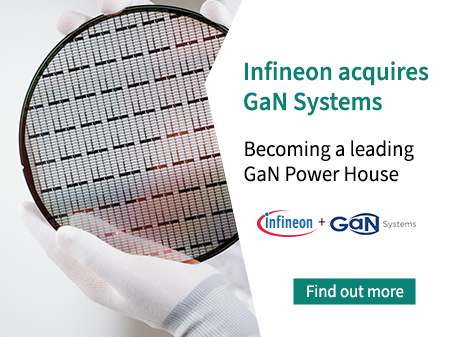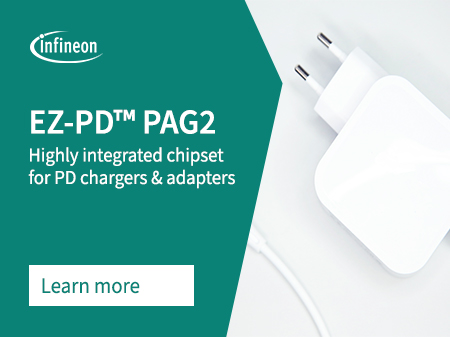USB-C adapters and chargers
From high power density to cost/performance - meeting any of your requirements
Avoid complexity, incompatibility, and shorten time-to-market with Infineon’s broad portfolio of high-quality USB-C PD solutions. They will help you break through the barriers in fast charging designs at a competitive cost.
USB-C power delivery (USB-PD) has emerged as the standard for unified and fast charging and for supplying power up to 100W for all kind of mobile devices such as smartphones, tablets, laptops, smart speakers, TVs and others. The latest released USB-PD Rev3.1 standard increases the maximum charging power even to 240W.
USB-C simplifies the end-user experience and together with the introduction of GaN devices and increasing switching frequencies it enables more compact and light-weight chargers and adapters.
More and more original equipment manufacturers (OEMs) no longer sell the chargers/adapters together with the devices, the end-user demand for aftermarket supply has increased.
This has triggered the development of multi-port chargers like 1A1C or 2C designs, 1A1C standing for a charger with one Type-C connector and one Type-A connector. EZ-PD™ CCG7DC is a 2-port USB hub IC specifically designed for dual port hubs, featuring two buck boost converters and full programmability for implementation of load sharing. Infineon’s dual port charger reference design application notes include the detailed 2-port USB hub circuit diagrams.
Making use of the highest USB-PD power rating requires specific USB E-Mark cables that support a maximum current of 5A , in contrast to standard cables limited to 3A.
Infineon offers a variety of charger reference designs and related USB charging schematics based on quasi-resonant (QR), ZVS and hybrid flyback operation, for different power levels and power density requirements. Our innovative single- and dual-port USB-C controllers are fully programmable and can be easily customized for specific requirements.
The USB Type-C charger schematic designs and USB charger adapter circuit diagrams feature Infineon’s comprehensive portfolio of silicon and gallium nitride based high- and low-voltage power switches, USB-PD power and protocol controllers, USB-C cable marker controllers as well as ESD protection devices.
Our reference designs allow for the quick and easy development of prototypes, meaning manufacturers can benefit from new, fast-charging adapter technology while reducing development costs and time to market. Thanks to decades of experience in the electronics industry, Infineon drives the trend of adapter miniaturization without compromising on product efficiency and performance.
USB-PD charging technology
USB power delivery (USD-PD) is a universal standard to charge or supply any device with a USB-C port, including those with higher power ratings, such as hard drives, printers, laptops, and smartphones with a large battery capacity. USB-PD chargers and adapters can be used to power such a wide variety of devices as they supply the requested amount of power needed. The power source and sink communicate through the USB-PD protocol and the sink defines how much power is required. The charging voltage and current are adjusted accordingly by the power source, the USB-PD charger or power adapter.
GaN charger technology
Infineon's innovative CoolGaN™ technology sets a new standard for power transistors. CoolGaN™ products feature gallium nitride (GaN) transistors instead of silicon. Their higher critical electrical fields enable outstanding specific dynamic on-state resistance and smaller capacitances compared to silicon MOSFETs, which makes GaN HEMTs great for high speed switching applications. Gallium nitride transistors can be operated with reduced dead-times which results in higher efficiency and better thermals. Operation at high switching frequencies allows the volume of passive components to shrink which improves overall power density. GaN enables for smaller and lighter chargers and adapters.
System diagram: USB power delivery

- Get to know the history of USB
- Receive an overview of the USB-C market trends and challenges
- Get familiar with Infineon’s total solution for USB-C PD
- Watch now
- Watch chinese version
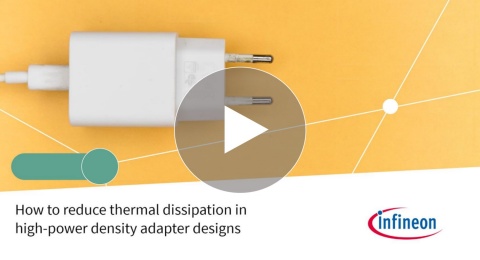
Key takeaways:
- Introduction to power adapters and its system requirement
- Know the design flow for power adapters
- Know how to select and verify the components from thermal point of view
- Watch here
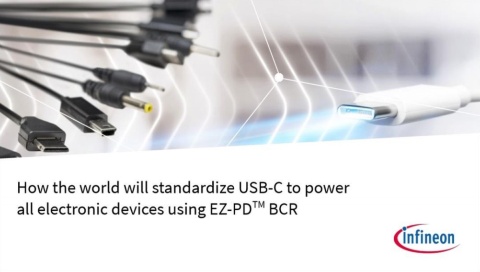
In this training, you will gain more insight on the benefits of replacing an old barrel power connector with USB-C and how to do it.
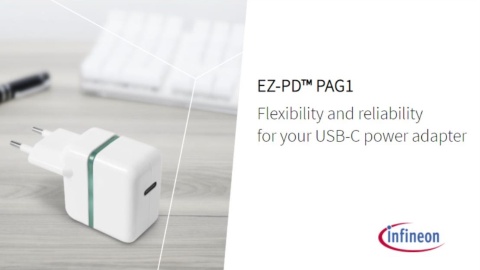
Key takeaways:
- Understand what EZ-PD™ PAG1 consists of and why it is a great solution to lower the BoM
- Get guidance on how to ensure flexibility with Infineon’s EZ-PD™ Configuration Utility tool
- Discover the EZ-PD™ PAG1 reference design offers


